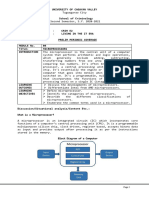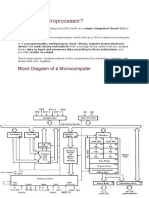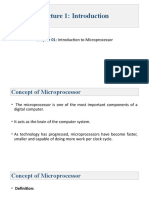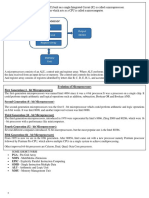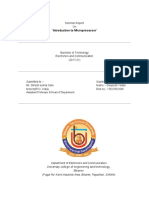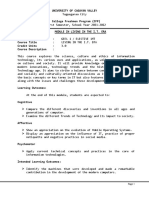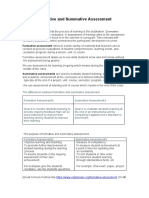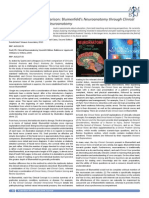UNIVERSITY OF CAGAYAN VALLEY
Tuguegarao City
College Freshmen Program (CFP)
First Semester, School Year 2021-2022
MODULE IN LIVING IN THE I.T. ERA
Course Code : GEEL 1 / ELECTIVE 1MT
Course Title : LIVING IN THE I.T. ERA
Credit Units : 3.0
Course Description :
This course explores the science, culture and ethics of information
technology, its various uses and applications, as well as its influence
on culture and society. It will provide knowledge on new technologies,
modern innovations, technology trends and the history of Information
Technology age. It aims to strike a balance between conceptual instruction
and socially and culturally-oriented discussions as it not only explains
the basic concepts or key terms in IT but also features the major IT trends
along with the issues and challenges these developments bring.
Learning Outcomes:
At the end of this module, students are expected to:
Cognitive
Compare the different discoveries and inventions in all ages and
generations of computer.
Examine the different Trends of Technology and its impact to society.
Affective
Show an appreciation on the evolution of Mobile Operating Systems.
Display an appreciation on the influence of IT, practice of proper
netiquette and negative practices in social media.
Psychomotor
Apply current technical concepts and practices in the core of
information technologies.
Intended Learning Outcomes:
Discuss the developments of microprocessors and how it works.
Differentiate Intel from AMD microprocessors.
Page 1
� UNIVERSITY OF CAGAYAN VALLEY
Tuguegarao City
College Freshmen Program (CFP)
First Semester, School Year 2021-2022
LESSON 4. MICROPROCESSORS
What is a Microprocessor?
Computer's Central Processing Unit (CPU) built on a single Integrated
Circuit (IC) is called a microprocessor.
A digital computer with one microprocessor which acts as a CPU is called
microcomputer.
It is a programmable, multipurpose, clock-driven, register-based
electronic device that reads binary instructions from a storage device
called memory, accepts binary data as input and processes data according
to those instructions and provides results as output.
The microprocessor contains millions of tiny components like transistors,
registers, and diodes that work together.
Working of Microprocessor
The microprocessor follows a sequence to execute the instruction: Fetch,
Decode, and then Execute.
Initially, the instructions are stored in the storage memory of the
computer in sequential order. The microprocessor fetches those
instructions from the stored area (memory), then decodes it and executes
those instructions till STOP instruction is met. Then, it sends the result
in binary form to the output port. Between these processes, the register
stores the temporary data and ALU (Arithmetic and Logic Unit) performs the
computing functions.
Basics of Microprocessor
A microprocessor takes a bunch of instructions in machine language and
executes them, telling the processor what it has to do. Microprocessor
performs three basic things while executing the instruction:
1. It performs some basic operations like addition, subtraction,
multiplication, division, and some logical operations using its
Arithmetic and Logical Unit (ALU). New microprocessors also perform
operations on floating-point numbers also.
2. Data in microprocessors can move from one location to another.
Page 2
� UNIVERSITY OF CAGAYAN VALLEY
Tuguegarao City
College Freshmen Program (CFP)
First Semester, School Year 2021-2022
3. It has a Program Counter (PC) register that stores the address of
the next instruction based on the value of the PC, microprocessor
jumps from one location to another and takes decisions.
A typical Microprocessor structure looks like this:
Types of Microprocessors
Complex Instruction Set Microprocessor
The processors are designed to minimize the number of instructions per
program and ignore the number of cycles per instructions. The compiler is
used to translate a high level language to assembly level language because
the length of code is relatively short and an extra RAM is used to store
the instructions. These processors can do tasks like downloading, uploading
and recalling data from memory. Apart from these tasks these
microprocessors can perform complex mathematical calculation in a single
command.
Example: IBM 370/168, VAX 11/780
Reduced Instruction Set Microprocessor
These processors are made according to function. They are designed to
reduce the execution time by using the simplified instruction set. They
Page 3
� UNIVERSITY OF CAGAYAN VALLEY
Tuguegarao City
College Freshmen Program (CFP)
First Semester, School Year 2021-2022
can carry out small things in specific commands. These processors complete
commands at faster rate. They require only one clock cycle to implement a
result at uniform execution time. There are number of registers and less
number of transistors. To access the memory location LOAD and STORE
instructions are used.
Example: Power PC 601, 604, 615, 620
Super Scalar Microprocessor
These processors can perform many tasks at a time. They can be used for
ALUs and multiplier like array. They have multiple operation unit and
perform tasks by executing multiple commands.
Application Specific Integrated Circuit
These processors are application specific like for personal digital
assistant computers. They are designed according to proper specification.
Digital Signal Multiprocessor
These processors are used to convert signals like analog to digital or
digital to analog. The chips of these processors are used in many devices
such as RADAR, SONAR, home theatres, etc.
Features of Microprocessor
o Low Cost - Due to integrated circuit technology microprocessors are
available at very low cost. It will reduce the cost of a computer
system.
o High Speed - Due to the technology involved in it, the microprocessor
can work at very high speed. It can execute millions of instructions
per second.
o Small Size - A microprocessor is fabricated in a very less footprint
due to very large scale and ultra large scale integration technology.
Because of this, the size of the computer system is reduced.
o Versatile - The same chip can be used for several applications,
therefore, microprocessors are versatile.
o Low Power Consumption - Microprocessors are using metal oxide
semiconductor technology, which consumes less power.
o Less Heat Generation - Microprocessors uses semiconductor technology
which will not emit much heat as compared to vacuum tube devices.
Page 4
� UNIVERSITY OF CAGAYAN VALLEY
Tuguegarao City
College Freshmen Program (CFP)
First Semester, School Year 2021-2022
o Reliable - Since microprocessors use semiconductor technology,
therefore, the failure rate is very less. Hence it is very reliable.
o Portable - Due to the small size and low power consumption
microprocessors are portable.
Advantages of Microprocessor
1. High processing speed
2. Compact size
3. Easy maintenance
4. Can perform complex mathematics
5. Flexible
6. Can be improved according to requirement
Disadvantages of Microprocessors
1. Overheating occurs due to overuse
2. Performance depends on size of data
3. Large board size than microcontrollers
4. Most microprocessors do not support floating point operations
The Microprocessor as a Turning Point for Modern Computing
CPUs used to be enormous. It was the successful development of the
microprocessor that led to the home computer. General purpose
microprocessors are what allows our computers to be used for text editing,
multimedia display, computation, and communication over the Internet.
Because of how fast, small, and energy-efficient they are, they have been
integral to the development of everyday technology, including appliances,
smartphones, and more.
Intel Microprocessor
Intel is the world’s largest manufacturer of PC microprocessors and the
holder of the x86 processor architecture patent.
Intel 4004, released in 1971, was one of the first microprocessors ever
produced. x86 is the series of Intel microprocessor families that began
with the 80286 microprocessors. Often called simply the 286, 80286 was a
16-bit microprocessor chip introduced in 1982. The 80286 introduced a new
generation of microprocessors with memory management. It also offered more
than twice as much performance per clock cycle as the 8086 or 8088. It
Page 5
� UNIVERSITY OF CAGAYAN VALLEY
Tuguegarao City
College Freshmen Program (CFP)
First Semester, School Year 2021-2022
quickly became popular and could be found in many machines into the 1990s.
In 1985, Intel introduced the successor to the 80286, the 80386 (386), a
32-bit processor. The Pentium, first offered in 1993, quickly replaced
Intel's subsequent 486 as the microchip-of-choice for PCs.
Itanium was Intel's first microprocessor based on the 64-bit architecture
known as IA-64. The Intel Core series, which launched in 2006, includes
Sandy Bridge, Ivy Bridge and Haswell processors. In 2013, Intel announced
Quark, an embedded system-on-a-chip (SoC) processor design intended for
smaller mobile devices like wearable computers.
The company has also produced embedded processors, SRAM, DRAM, flash,
integrated circuits (IC), network interface controllers, and motherboard
and graphics chipsets. Intel competes primarily with AMD, the world’s
second-largest manufacturer of processors.
Gordon Moore, famous for Moores law, and Robert Noyce, co-inventor of the
IC, founded Intel in 1968. The company is headquartered in Santa Clara,
California.
Advanced Micro Devices (AMD) Microprocessor
In 1969, Jerry Sanders and Edwin Turney started up a company which would
produce products such as processors, microprocessors, and motherboard
chipsets. The company they started was called Advanced Micro Devices or
AMD. The processors AMD produced consisted of basic components, the ALU,
or Arithmetic Logic Unit and the Control Unit. AMD was incorporated in
1969 but their first processor like component didn't release until 1970
with the Am2501 logic counter. At this point, the company was still public
but that changed in 1972. When the 1980s came around, AMD started to take
off because two main reasons. The first was AMD had expanded their
producing facilities to other states, which made the company much larger.
The second reason was IBM, in 1982, offered AMD a contract with Intel
giving AMD the rights to make the 8086 and the 8088 processors. This pact
lasted until 1986 when the demand and sales of AMD chips plummeted. This
led AMD to research microprocessors that were going be able to be
compatible with network and communication chips as well as IBM computers.
The 90s were a very important time period for AMD because with the release
of the Am386 chip, they broke the monopoly that Intel had on the CPU
market. Compaq struck a long-term deal with AMD in 1994 to supply the AMD
486 chips in Compaq computers. In 1997 AMD had a breakthrough making a
Page 6
� UNIVERSITY OF CAGAYAN VALLEY
Tuguegarao City
College Freshmen Program (CFP)
First Semester, School Year 2021-2022
microprocessor that would be affordable for the average every day home
user. The price of a personal computer was now below $1,000 with the
release of the AMD-K6 microprocessor. AMD was also the first processor to
be brand to make a seventh-generation processor for Microsoft windows
computing in 1999 with the AMD Athlon MP processor. That same processor
was the first to break the 1GHz barrier in processors in 2000. AMD continued
to up their processors but the next major move didn't happen until 2006
when AMD bought ATI Technologies Inc., which gave AMD into 3d graphics
chips the next year AMD introduced the ATI Radeon HD 2000 graphic
processors. These processors were used in both PCs and Mobile phones.
Difference between Intel and AMD
Intel AMD
Less expensive than AMD Less expensive than Intel at a higher
Processor at the lower range. range.
More efficient than AMD. Less efficient than Intel.
Is generally cooler due to smaller
Can heat up when used with lithography(TSMC 7nm is similar to
Clock Speed Boost(14 nm) Intel 10 nm)
IPC (Rocket Lake) is lower than IPC(Zen 3) is higher than Intel (Rocket
AMD (Zen 3) Lake)
Clock speed reaches and The clock speed can reach 5.0 GHz but
surpassed 5.0 GHz results in more heat
iGPU present in almost all Core iGPU is present only in AMD APU series
i series CPU(except Core i F- with higher GPU performance compared to
series) Intel iGPU(HD Graphics and)
It has symmetric It has symmetric multiprocessing
multiprocessing capabilities capabilities of up to 8 sockets/128
of up to 4 sockets/28 cores. cores.
Page 7
� UNIVERSITY OF CAGAYAN VALLEY
Tuguegarao City
College Freshmen Program (CFP)
First Semester, School Year 2021-2022
Basic Terms Used in Microprocessor
Instruction Set - The group of commands that the microprocessor can
understand is called Instruction set. It is an interface between hardware
and software.
Bus - Set of conductors intended to transmit data, address or control
information to different elements in a microprocessor. A microprocessor
will have three types of buses, i.e., data bus, address bus, and control
bus.
IPC (Instructions Per Cycle) - It is a measure of how many instructions a
CPU is capable of executing in a single clock.
Clock Speed - It is the number of operations per second the processor can
perform. It can be expressed in megahertz (MHz) or gigahertz (GHz). It is
also called the Clock Rate.
Bandwidth - The number of bits processed in a single instruction is called
Bandwidth.
Word Length - The number of bits the processor can process at a time is
called the word length of the processor. 8-bit Microprocessor may process
8 -bit data at a time. The range of word length is from 4 bits to 64 bits
depending upon the type of the microcomputer.
Data Types - The microprocessor supports multiple data type formats like
binary, ASCII, signed and unsigned numbers.
Page 8
� UNIVERSITY OF CAGAYAN VALLEY
Tuguegarao City
College Freshmen Program (CFP)
First Semester, School Year 2021-2022
References:
https://www.pvpsiddhartha.ac.in/dep_it/lecture%20notes/MP/unit1.pdf
https://www.geeksforgeeks.org/evolution-of-microprocessors/
https://www.javatpoint.com/microprocessor-introduction
https://computer.howstuffworks.com/microprocessor.htm
https://www.tutorialspoint.com/microprocessor/
https://electrosome.com/microprocessor/
https://www.brainspire.com/blog/what-is-a-microprocessor-and-how-does-
it-work
https://whatis.techtarget.com/definition/Intel
http://www.people.vcu.edu/~gasaunde/BriefsExample/web/Brief1.html
Prepared by:
IT INSTRUCTORS
Page 9

